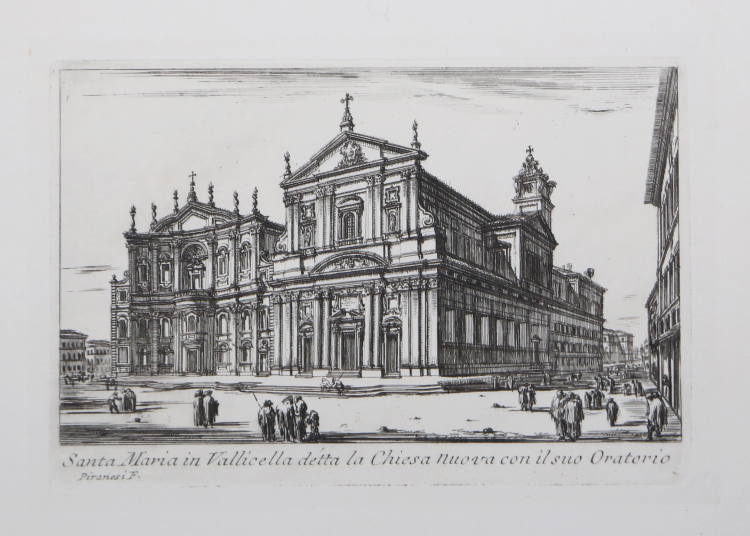



| Reference: | S28155 |
| Author | Giovan Battista PIRANESI |
| Year: | 1745 |
| Zone: | Santa Maria in Vallicella |
| Printed: | Rome |
| Measures: | 192 x 125 mm |


| Reference: | S28155 |
| Author | Giovan Battista PIRANESI |
| Year: | 1745 |
| Zone: | Santa Maria in Vallicella |
| Printed: | Rome |
| Measures: | 192 x 125 mm |
Etching, around 1745, signed in plate. A very good impression with full margins, in perfect condition.
Taken from the “Varie Vedute di Roma Antica, e Moderna. Disegnate e Intagliate da Celebri Autori” printe in Rome by Fausto Amidei, 1748.
The collection, in 4th oblong, is published by Fausto Amidei in various editions from 1745 to 1750, and by Giovanni Bouchard in 1752. It contained an engraved frontispiece and 93/96 plates, of which 47 signed by Piranesi and others by Giraud, Carloni, Nicole, Mogalli, Bellicard, Le Geay, and Anesi.
Early works by Piranesi, who had just arrived in Rome where he was a student of the workshop of Giuseppe Vasi. Vasi’s works will take the name of the 'Magnificenze di Roma'; from 1747; at the beginning of the work Piranesi joined him, but, at least since 1744, he produced his own views, which in 1745 formed the most important nucleus of the 'Varie Vedute di Roma antica e moderna disegnate e intagliate da celebri autori' for the bookseller and editor Amidei.
|
Wilton-Ely 66; Focillon 97
|
Giovan Battista PIRANESI (Mogliano Veneto 1720 - Roma 1778)
|
Italian etcher, engraver, designer, architect, archaeologist and theorist. He is considered one of the supreme exponents of topographical engraving, but his lifelong preoccupation with architecture was fundamental to his art. Although few of his architectural designs were executed, he had a seminal influence on European Neo-classicism through personal contacts with architects, patrons and visiting artists in Rome over the course of nearly four decades. His prolific output of etched plates, which combined remarkable flights of imagination with a strongly practical understanding of ancient Roman technology, fostered a new and lasting perception of antiquity. He was also a designer of festival structures and stage sets, interior decoration and furniture, as well as a restorer of antiquities. The interaction of this rare combination of activities led him to highly original concepts of design, which were advocated in a body of influential theoretical writings. The ultimate legacy of his unique vision of Roman civilization was an imaginative interpretation and re-creation of the past, which inspired writers and poets as much as artists and designers.
|
|
Wilton-Ely 66; Focillon 97
|
Giovan Battista PIRANESI (Mogliano Veneto 1720 - Roma 1778)
|
Italian etcher, engraver, designer, architect, archaeologist and theorist. He is considered one of the supreme exponents of topographical engraving, but his lifelong preoccupation with architecture was fundamental to his art. Although few of his architectural designs were executed, he had a seminal influence on European Neo-classicism through personal contacts with architects, patrons and visiting artists in Rome over the course of nearly four decades. His prolific output of etched plates, which combined remarkable flights of imagination with a strongly practical understanding of ancient Roman technology, fostered a new and lasting perception of antiquity. He was also a designer of festival structures and stage sets, interior decoration and furniture, as well as a restorer of antiquities. The interaction of this rare combination of activities led him to highly original concepts of design, which were advocated in a body of influential theoretical writings. The ultimate legacy of his unique vision of Roman civilization was an imaginative interpretation and re-creation of the past, which inspired writers and poets as much as artists and designers.
|